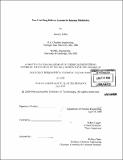Non-viral drug delivery systems for immune modulation
Author(s)
Fuller, Jason E., Ph. D. Massachusetts Institute of Technology
DownloadFull printable version (25.80Mb)
Other Contributors
Massachusetts Institute of Technology. Dept. of Chemical Engineering.
Advisor
Robert Langer.
Terms of use
Metadata
Show full item recordAbstract
Biodegradable polymer particles have diverse applications in drug delivery. The main objective of this thesis was to apply these delivery systems to modulating the immune system. We optimized particle formulations for the delivery of three novel immune modulating compounds, small inhibiting RNA, immunostimulatory RNA, and 3-1,6-glucan. Because microparticles formulated from PLGA and Poly(3-amino-ester) have been shown to target and transfect DNA in antigen presenting cells we studied their ability to knock down genes with siRNA. We discovered ways to improve particle morphology, encapsulation efficiency, and buffer the acidic microenvironment of degrading microparticles, all significant challenges with siRNA. We next used fluorescent nanoparticles as imaging agents to study these siRNA delivery challenges. Cationic polymers were deposited on the surface of fluorescent core-shell silica nanoparticles electrostatically; the resulting particles were complexed with a nucleic acid and delivered to cells. We screened a library of 60 unique formulations to identify an optimal protocol for DNA transfection demonstrating efficiency equal to PEI. We screened a library of 30 unique formulations for siRNA delivery and demonstrated knockdown of 25%. Confocal imaging showed that polymer coating increased localization of the nanoparticles to the cell membrane, endosomes and nucleus. Polycation surface-modification seemed broadly extendable to a biodegradable polymer particle delivery system for siRNA. Cationic lipids or lipidoids were promising polycations to apply to biodegradable particle surface-modification because they efficiently deliver siRNA. We screened 30 lipidoid formulations for optimal knockdown in P388-D1 macrophage cells, and isolated formulations that demonstrated up to 40% knockdown in P388-D1, 80% knockdown in primary macrophage, and 65% knockdown in mouse macrophage in vivo. (cont.) We formulated microparticles from PLGA/lipidoid blends that demonstrated nearly 80% knockdown in P388-D1. This same formulation also induced sequence specific interferon response to immunostimulatory RNA in human peripheral blood mononuclear cells. Finally we used PLGA microparticles to deliver a novel fungal cell wall component, 3-1,6-glucan, to neutrophils. This approach induced neutrophil expression of reactive oxygen species in vitro. In a mouse model of blood stream Candida albicans infection 60% of mice survived lethal doses when treated with the particles.
Description
Thesis (Ph. D.)--Massachusetts Institute of Technology, Dept. of Chemical Engineering, 2008. Includes bibliographical references.
Date issued
2008Department
Massachusetts Institute of Technology. Department of Chemical EngineeringPublisher
Massachusetts Institute of Technology
Keywords
Chemical Engineering.